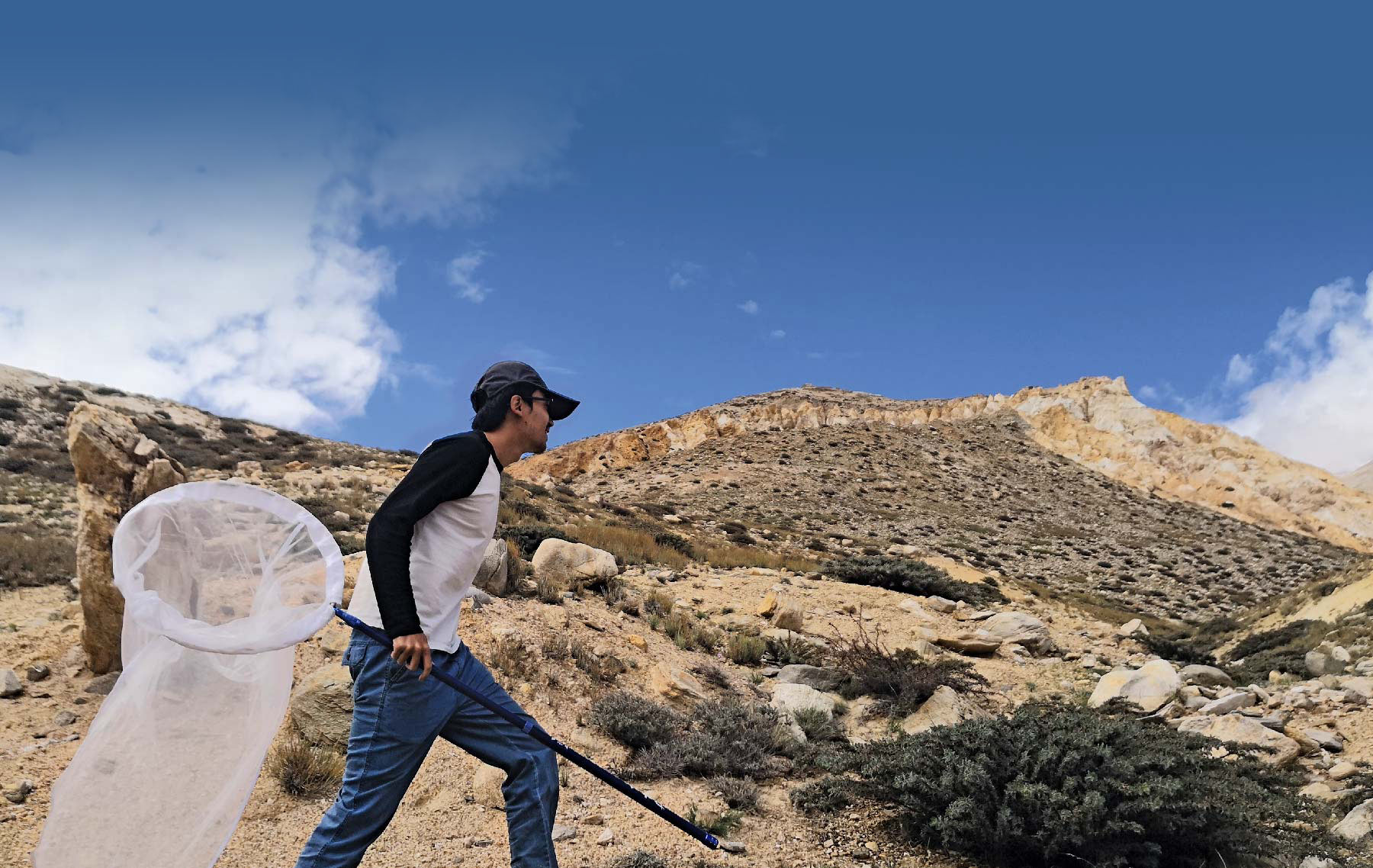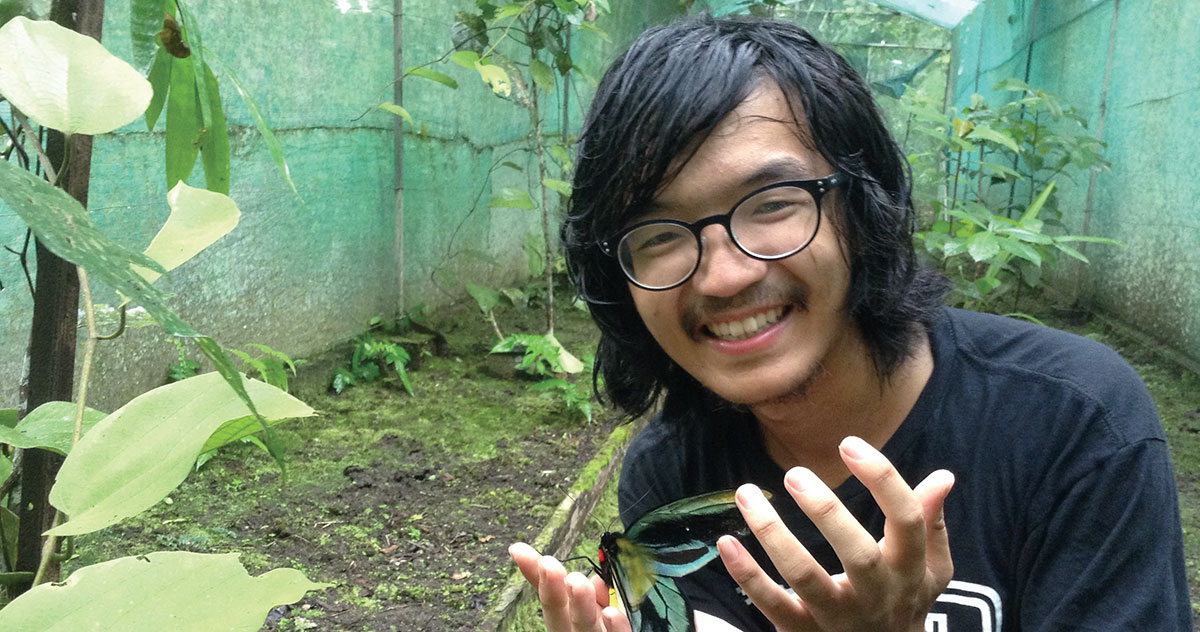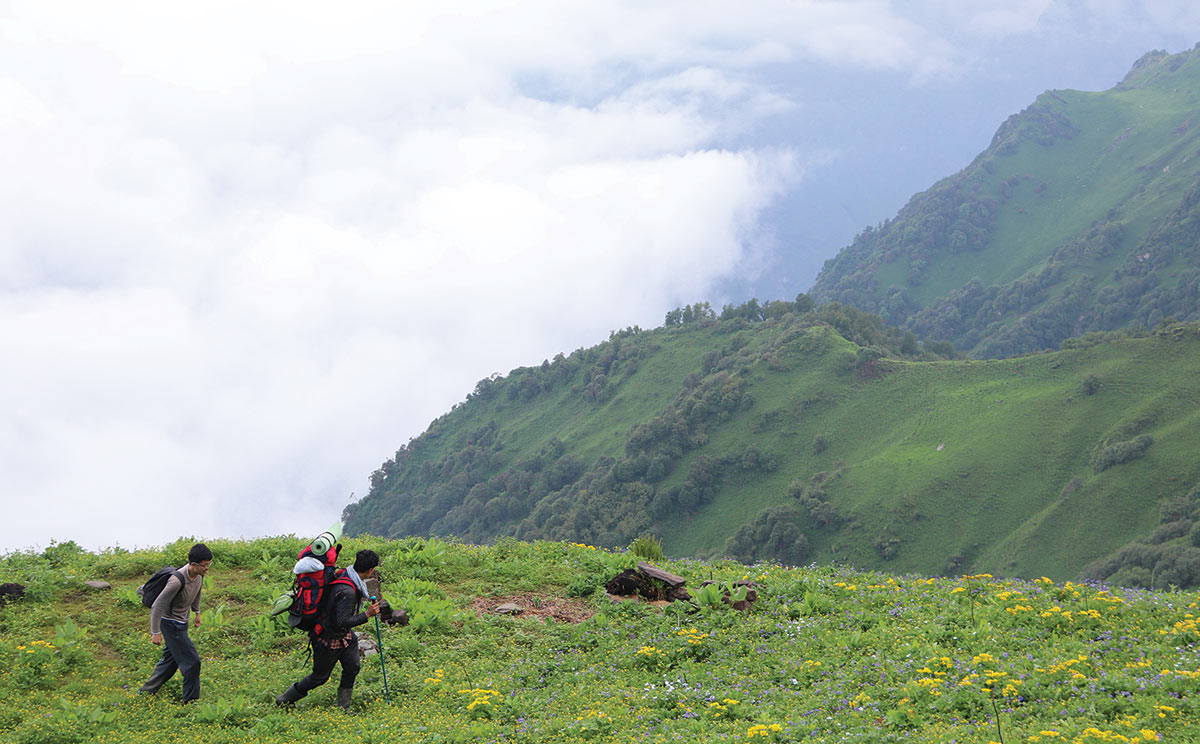Secrets of the Butterfly Hunter
by Kate Campbell

metallic green swallowtail butterfly native to Vietnam and the mountains of southern China, Teinopalpus aureus has been caught at the tangled heart of many poaching cases. Considered an endangered species, and under steady threat due to wildlife trade, it’s now guarded by law in China, receiving the same protection as the giant panda.
It also happens to be the favorite butterfly of conservation biologist Zhengyang Wang ’14, who earned his Ph.D. from Harvard University in May.
“It’s the first butterfly I tried to conduct field work on, when I was a junior at Swarthmore,” says Wang, a Watson Fellow in 2014 whose project, “Children of Butterflies: Ranching Beauty around the Globe” indeed took him around the globe.
“I had heard that the population was endangered because of poaching, and I wanted to study its habitat. My advisor Rachel Merz [Walter Kemp Professor Emerita in the Natural Sciences] encouraged me to apply for a summer stipend from the Biology Department.”
He still remembers when, after days of exhausting hiking, he saw his first T. aureus in a ritual courtship flight.
“I almost cried,” he says.
As it happens, the butterfly requires a very specific species of magnolia tree as host plant to survive. “And the host plant tree is even harder to find than the butterflies themselves,” he says. “I realized that the real threat to butterflies is not unregulated collection, but large landscape development projects that destroyed the butterflies’ host plants.”
Growing up at the foothills of the Hengduan Mountains in Chengdu, western China, Wang was fascinated by insects of all kinds. But butterflies held a singular status. He was an only child and his parents, who worked in forestry and agriculture, lovingly supported his interest.
“Now to be able to travel and study them as a career? At least in the past, that is something only aristocrats could afford. Now, so could I,” says Wang, who still seems in awe of having a job researching and working in conservation.
Though saving the planet and making the world a better place are among his motivations, Wang says he savors the experience of doing exactly what he always wanted to do. “Honestly, the best part of the work is the sheer freedom of working on things I’m passionate about,” he says. Some people choose the career path of conservation biology after watching documentaries, Wang says. “They imagine themselves spending their days strolling around the rainforest counting hundreds of tropical birds and butterflies — I’m certainly one of those people — and there’s nothing wrong with that.”
The daily grind of conservation science, though, requires a less romanticized view. “There are countless hours of sitting in front of a laptop and learning complicated statistical pipelines, not to mention the pressure of publishing papers in academia,” says Wang. “All of this at times can be dull and disheartening, but good conservation policy is based on solid scientific evidence, and that requires more than just nature-loving wanderlust.”

Mike Huben
Zhengyang Wang ’14 after a day of insect collecting this summer near Tena, Ecuador.

Conwell Nukara
Wang holds an endangered Queen Alexandra’s birdwing butterfly at Popondetta, Papua New Guinea, during his Watson Fellowship travels.

Kun Qin
The Evolutionary History of Caterpillar Fungus
Apart from endangered butterflies, Wang also studies the ecology and evolutionary history of caterpillar fungus, a term for moth caterpillars parasitized by a particular strain of fungi. Caterpillar fungus is only found in the high-elevation meadows of the Hengduan Mountains and the Himalayas. “The symbiosis was first documented by Tibetan scholars in the 15th century and has been collected by local people for its ethnomedicinal value for more than 500 years,” says Wang.
Collecting and selling caterpillar fungus today provides substantial income to many Tibetan families, he says. His doctoral thesis investigated the conditions under which this symbiosis forms, and the biogeographical patterns of both the caterpillar host and the fungal parasite.
“I’m extremely lucky and privileged to have been able to pursue my work with the full support from my department and my thesis committee,” he says. “Studying caterpillar fungus in their habitat brought me to some of the most stunning landscapes on this planet.”
Hiking across glaciers, he has often stopped just to absorb the breathtaking magnitude of his surroundings. “I would look up to see the blue sky and the snow peaks — they remind me of how trivial my own existence is compared with the true majesty of nature,” says Wang. “It’s also a lesson in taking different perspectives and understanding communities and people.”
In his research, Wang relies heavily on local stakeholders to grant him access to their collecting habitat, which is often sacred. “I’m grateful they trust me as a scientist who would not exploit their kindness,” he says. “Wherever I visit, I’m treated with the most compassion and hospitality.”
Genetic Barcodes to Help Caterpillar-fungus Collectors Authenticate their Product? Yes, That’s a Real Thing
During COVID-19, when field research was not possible, Wang focused on other means of study. “I would tinker in the lab to see whether I could use ancient-DNA techniques to extract genetic fragments from old, dry caterpillar fungus samples sold across the Himalayas,” he says. “My hope was that these techniques would reveal genetic barcodes unique to the region [where] each caterpillar fungus sample belongs, and that I could use these barcodes to authenticate the samples for local collectors.”
Caterpillar fungus collected in Darchula, Nepal, Wang says, are often masked as samples from Tibet and exported at a slightly lower price. With his authentication process, collectors in Darchula can be appropriately compensated in the market. “This is still a work in progress, but I see a lot of practical applications,” Wang says. “I’m excited by it.”
Another project Wang pursued during the pandemic was studying people’s perception of insects online. Insect names appear at different frequencies on search engines, he says. People post photos of insects asking for identifications — some even bid for insect specimens.
“I want to know what these activities say about our love-hate relationships with insects,” Wang says, “and whether insights could be gleaned from the internet to help us craft better conservation policies.”
One surprising discovery: “Endangered” insects in general receive less press and scientific attention than common insects, Wang says.
“It’s almost like the public chooses to forget about insect species that are considered beyond saving,” he says. “These results bring me much concern for well-intentioned conservation measures, such as listing Monarch butterflies as endangered.”
Gaining endangered status makes a species more likely to be targeted by poachers, Wang says, while researchers have to submit to a more arduous permitting process to study them. “It’s really a kind of double whammy,” he says. “The best way to protect butterflies, really, is to make sure they still have a functioning habitat.”
The Speed of Landscape Change
“The speed of landscape change is jaw-dropping,” he says. In Wang’s first summer as a graduate student, he studied the habitat of the Bhutan Glory butterfly on the foothills of Mount Gongga in Sichuan. From Chengdu, the nearest metropolis, he says it took a 12-hour bus ride along a winding valley road to get there. “Today a highway cuts directly from the city into the heart of Mount Gongga,” Wang says. “Along the way, rivers, forests and mountains have been decimated. The speed at which development progresses in Mount Gongga is not uncommon in the Hengduan and Himalayas.”

courtesy of Darong Yang.
Wang (left) follows Labindha, a local villager, to visit a caterpillar fungus habitat in Munsiyari, India. Caterpillar fungus has been traded in the region and imported to China, but the exact species of its host remains unknown. “Most people hear about ‘insect conservation’ and think of mosquitoes and cockroaches, and wonder why on earth one would ever make an effort to protect them,” says Wang. “It’s relatively easy to ask people to care about large mammals such as tigers and pandas — they are cute and fluffy — but it has always been an uphill battle to ask people to care about insects, even though more than 80% of all the world’s species are insects and they provide immense ecosystem service to us.”
Though some demonize economic development when nature is tampered with, Wang says it’s not his place to judge. “Even as a conservationist, I’m more hesitant to make judgments,” he says. “Things like roads, schools, and free markets are essential to building local conservation capacity, and that’s what eventually matters — one doesn’t think about conservation when there are hungry family members to feed.”
Local stakeholders should decide what kind of development plan is sustainable, he says. “I believe that humans, when informed and educated, will make sound decisions. So maybe, after all, I’m still an optimist.”
All Tangled Together
Wang was initially amazed at how a fungus could parasitize caterpillars. “Then my own research showed that these same fungi also reside mutualistically in plants, and also that the caterpillars eat about 20 different families of plants,” he says. “Other scientists have shown that the bacterial community inside each caterpillar’s gut is also different depending on whether a fungal infection has happened.”
His takeaway with each discovery is the theme of interconnectedness.
“It’s all tangled together,” Wang says. “I wouldn’t be surprised if someone showed that certain strains of virus were also involved in the fungal infiltration of the caterpillar exoskeleton. It seems that many things in nature are connected, and all in a constant flux in search for optimal strategies of survival. Having this in mind really helps me deal with my life on a day-to-day basis.”
Caring so deeply about butterflies — It’s self-preservation
“If you really tried to stare into the compound eyes of a botfly and still couldn’t see their immense intelligence and beautiful souls, and if you choose to be willfully ignorant of the fact that most of your fruits and vegetables are pollinated by insects, and that many of your favorite M&M candies are dyed with scale insects, maybe think like this. … insects are highly sensitive to their host plants and environment, so the best way to conserve insects is in fact to conserve their habitat,” says Wang. “This takes care of conserving the birds and mammals and humans residing in them. In the end, this could be a highly selfish argument — the ends of insect conservation meet the means of our own preservation.”